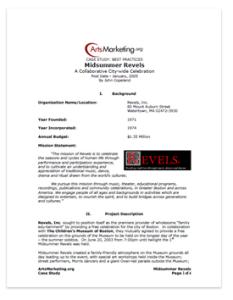
Author: Kaplan, Aaron
Publication Year: 2002
Media Type: Case study
Summary:
This case study reviews efforts of the New York Chinese Cultural Center to create a segmented markeing strategy.
Abstract:
"The New York/New Jersey metropolitan area is home to second largest concentration of Chinese - American residents in the U.S. Current trends show that the Chinese - American population is growing and diversifying. The immigrant generations speak a wide range of Chinese dialects and possess many cultural differences. Adding to the mix are new generations whose primary language is English. All these trend s contribute to a much more segmented market than the New York Chinese Cultural Center (NYCCC) faced when it was founded in 1973. Historically, NYCCC had always marketed its programs through the Chinese language media and by word of mouth and gotten succe ssful results. Today’s Chinese Americans are much more assimilated into mainstream American life and get much of their information from non - Chinese media sources. However, the NYCCC’s artistic staff is made up of primarily Chinese immigrants with limited English language skills; additionally, the administrative staff members have difficulties with internal and external communication due to the language barrier, thus creating short - term audience development efforts that only addressed its immediate needs.
NYCCC’s current facility is situated in a neighborhood on the outskirts of Chinatown, Tribeca and Soho. This area was once populated with fabric stores and garment factories. Chinese parents favored this location because it was safely distanced from C hinatown’s main street activities, yet within walking distance to Chinatown. Today, many different forms of public transportation including eleven subway lines, and three major bus lines make NYCCC’s neighborhood easily accessible. The PATH train to New J ersey is a ten - minute walk or two subway stops away. The Holland Tunnel entrance to New Jersey is only five blocks away, and the Brooklyn Bridge is seven blocks south.
In the last five years, the neighborhood has undergone many changes. More buildings a re being converted to multi - unit residential condominiums, and the increased number of retail stores such as Banana Republic, Armani and Nine West is making the area a more desirable location for its residents. These changes in area demographics have also provided an opportunity for NYCCC to play up the convenient and exciting location to its potential students and their families.
These demographic and geographic changes also present many challenges. There is a trend among the more affluent and educated Chinese - American families to move to suburban areas and not return to urban centers. On a regular basis, NYCCC has to combat the perception that Chinatown is a dangerous place. NYCCC also has to distinguish itself from the abundant entertainment choices t hat it is directly competing against for audience members.
Recognizing the changes and challenges brought to light by these trends, NYCCC needed to develop segmented communication strategies to:
- Increase audience development by highlighting the benefits of its location.
- Make sure it reached out to the broadest segment of the Chinese - American population." [p.1-2]
Arts & Intersections:
Categories: Marketing and Communications
ADDITIONAL BIBLIOGRAPHICAL INFORMATION
PUBLISHER INFORMATION
Name: Americans for the Arts (ArtsMarketing.org)
Website URL: http://www.artsmarketing.org